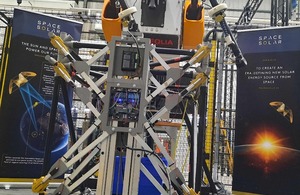Robotics demo points to interstellar future
UKAEA and Space Solar have collaborated on a robotics demonstration unit to pave the way for space-based data centres, solar farms and other megastructures.

AlbaTRUSS Single Transporter at UKAEA's Culham Campus - Image Credit: Space Solar
A collaboration between the United Kingdom Atomic Energy Authority (UKAEA), the UK鈥檚 national organisation responsible for the research and delivery of sustainable fusion energy, and space-tech innovator, Space Solar, has shown that robotic technology could build infrastructure in space without human intervention.
The AlbaTRUSS project, conducted at UKAEA鈥檚 advanced test facilities on Culham Campus, Oxfordshire, used remotely operated dual-arm robotic manipulators to show that robots could assemble gigawatt-scale solar power satellites.
The successful demonstration opens the door to building vast infrastructure projects in orbit, such as data centres and energy farms.
Dr Sam Adlen, Co-CEO of Space Solar, said:
The AlbaTRUSS project is a milestone not just for our satellite architecture, but for the future of large-scale structures in space, from data centres to energy infrastructure.
Space Solar aims to harness abundant solar energy in space to provide power to energy-hungry consumers on Earth. Its space-based solar technology requires satellites comprised of hundreds of thousands of modular units to be put together in orbit.
鈥淯p in space, the sun shines 24-7. Once constructed, these satellites capture solar power and beam it back down to Earth in the form of microwaves, which can be received by antennas on the ground and converted into electricity for the grid,鈥� explained Dr Adlen.
The structures are designed to be several kilometres long and around 20 meters wide.
AlbaTRUSS, a proof-of-concept project, showed that robots could assemble a scaled structural truss bay, or tubing called longeron, which forms a core element of the satellite鈥檚 framework. 聽
Unlike the International Space Station 鈥� the largest structure built in space to date 鈥� most satellites are single structures or feature only small additional elements that must be deployed in space.
Using robots to remotely assemble, maintain and decommission infrastructure is more efficient and reduces the risks faced by astronauts.
Space Solar used UKAEA鈥檚 centre for Remote Applications in Challenging Environments (RACE) because fusion and space robotics have a number of things in common 鈥� they don鈥檛 require oxygenated environments and can function in varying degrees of radiation.
Professor Rob Buckingham, Executive Director of UKAEA, said:
Building a machine as complicated as a fusion power plant on Earth, which will be entirely remotely operated, is similar to building structures in space. It could be a lunar station or a facility on Mars, so we鈥檙e talking about the future of humanity as well as ensuring energy security.
Working closely with people in adjacent fields is vital for UKAEA. By enabling new perspectives, it inspires our staff to think of different ways to solve challenges. It is hugely valuable to both parties.
Space-based solar power and fusion energy each have the potential to deliver constant, low-carbon baseload energy around the world. This partnership demonstrates that the UK is leading on multiple fronts to develop new sustainable energy sources.
The UKAEA-Space Solar partnership intends to strengthen the UK鈥檚 leadership in the fast-growing In-Space Assembly and Manufacturing (ISAM) sector. 聽
鈥淭his achievement opens up new horizons for the space sector, an adjacent economic sphere that can ensure a bright future here on Earth,鈥� concluded Dr Adlen. 聽
The AlbaTRUSS project was supported by the Science and Technology Facilities Council鈥檚 Proof of Concept grant.
Space Solar plans to commission its first 30MW demonstrator system by 2029 and reach full gigawatt-scale capacity by the early 2030s.